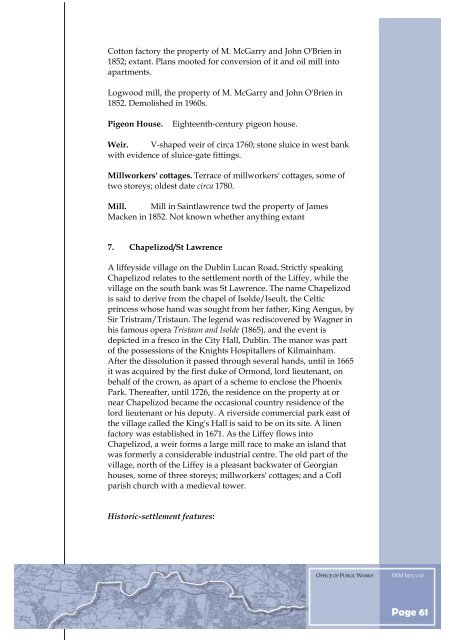Towards a Liffey Valley Strategy Doc. 1 - Kildare.ie
Towards a Liffey Valley Strategy Doc. 1 - Kildare.ie
Towards a Liffey Valley Strategy Doc. 1 - Kildare.ie
Create successful ePaper yourself
Turn your PDF publications into a flip-book with our unique Google optimized e-Paper software.
Cotton factory the property of M. McGarry and John O'Br<strong>ie</strong>n in<br />
1852; extant. Plans mooted for conversion of it and oil mill into<br />
apartments.<br />
Logwood mill, the property of M. McGarry and John O'Br<strong>ie</strong>n in<br />
1852. Demolished in 1960s.<br />
Pigeon House. Eighteenth-century pigeon house.<br />
Weir. V-shaped weir of circa 1760; stone sluice in west bank<br />
with evidence of sluice-gate fittings.<br />
Millworkers' cottages. Terrace of millworkers' cottages, some of<br />
two storeys; oldest date circa 1780.<br />
Mill. Mill in Saintlawrence twd the property of James<br />
Macken in 1852. Not known whether anything extant<br />
7. Chapelizod/St Lawrence<br />
A liffeyside village on the Dublin Lucan Road. Strictly speaking<br />
Chapelizod relates to the settlement north of the <strong>Liffey</strong>, while the<br />
village on the south bank was St Lawrence. The name Chapelizod<br />
is said to derive from the chapel of Isolde/Iseult, the Celtic<br />
princess whose hand was sought from her father, King Aengus, by<br />
Sir Tristram/Tristaun. The legend was rediscovered by Wagner in<br />
his famous opera Tristaun and Isolde (1865), and the event is<br />
depicted in a fresco in the City Hall, Dublin. The manor was part<br />
of the possessions of the Knights Hospitallers of Kilmainham.<br />
After the dissolution it passed through several hands, until in 1665<br />
it was acquired by the first duke of Ormond, lord l<strong>ie</strong>utenant, on<br />
behalf of the crown, as apart of a scheme to enclose the Phoenix<br />
Park. Thereafter, until 1726, the residence on the property at or<br />
near Chapelizod became the occasional country residence of the<br />
lord l<strong>ie</strong>utenant or his deputy. A riverside commercial park east of<br />
the village called the King's Hall is said to be on its site. A linen<br />
factory was established in 1671. As the <strong>Liffey</strong> flows into<br />
Chapelizod, a weir forms a large mill race to make an island that<br />
was formerly a considerable industrial centre. The old part of the<br />
village, north of the <strong>Liffey</strong> is a pleasant backwater of Georgian<br />
houses, some of three storeys; millworkers' cottages; and a CofI<br />
parish church with a med<strong>ie</strong>val tower.<br />
Historic-settlement features:<br />
OFFICE OF PUBLIC WORKS ERM IRELAND<br />
Page 61
















